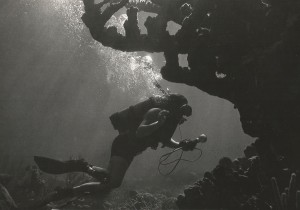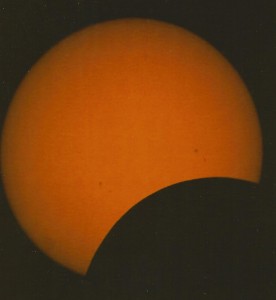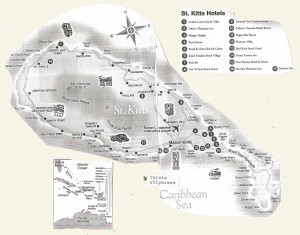Memorable Moment: Diving A Shipwreck During A Solar Eclipse
When Wayne Valero asked me to share one of my most memorable moments underwater, I couldn’t help reminiscing about my trip to St. Kitts in February 1998. That’s where I witnessed the last solar eclipse in the southern hemisphere before the millennium. While my fellow journalists were lining up to watch the eclipse from Brimstone Hill Fortress, 3,700 feet above sea level, I experienced it on a shipwreck in 50 feet of water.
Divemaster Nikki Sinibaldi of St. Kitts Scuba, Ltd., Don Mossman of Norwalk, Ohio, and I joked as we geared up for a dive we knew would be different from any others we had ever experienced. “I feel like we’re timing labor contractions,” Nikki quipped as we debated when to leave the boat. First mate Bobby Archibald reeled off the times: “Now 1:45, now 1:50, now 2 p.m.,” while Captain Dennis Fleming peered at the sun through protective glasses. “It’s almost half covered, so you better go,” he urged.
The sun’s rays still filtered through the clear water as we reached the remains of the Talata, a small freighter wrecked off the island’s capital, Basseterre, in 1985. The vessel had taken a beating from storms throughout the years, but the bow was still intact. The rest of it was pretty beat-up. We started to lose light as we swam toward the stern, where a big green moray ruled supreme in part of the wreck that resembled a cage.At 2:30 p.m., close to the culmination of a total eclipse, the 80-foot visibility dropped drastically and the shipwreck suddenly became a twilight zone. Our underwater lights revealed blackbar soldierfish retreating to the inner recesses of the wreck where they usually spent the night. Blue-striped grunts, content to school almost motionless a few minutes earlier, grew restless and swam haphazardly in all directions. A school of crevalle jacks, cruising on the perimeter of a nearby coral reef, peeled off like fighter planes and buzzed the shadows of the ship’s stern.
One lone lobster came out of its hiding place, looked around, and returned to its lair. The big green moray moved nervously back and forth in its ironclad dwelling, but never ventured out. Most of the fish began to forage for dinner as they usually do at dusk, but their strange behavior didn’t last long. When the moon completed its covering phase, dim rays of sunlight returned to the Caribbean Sea and its inhabitants resumed their normal protocol.Back aboard the boat, Nikki said she really didn’t think we fooled Mother Nature. Yet the nature of our dive was unique, just like the rest of my visit to St. Kitts and its sister island, Nevis. St. Kitts, 18 miles long and 5 miles wide, is located in the Eastern Caribbean. The west side of the island borders the Caribbean Sea, while the east coast faces the Atlantic Ocean. The island is consolidated with nearby Nevis to form a single island federation. On a clear day, from both St. Kitts and Nevis, you can see St. Maarten, Antigua, Saba, St. Bart’s and St. Eustatius, all islands of the Lesser Antilles. Located approximately 1,300 miles southeast of Miami, Florida, they’ve all become popular dive destinations.
To see another one of the Wreckmaster’s memorable dives—this one off the island of Nevis– go to: The Christena: A Sad Caribbean Saga, posted October 29, 2012.
6 Comments
Submit a Comment
All Rights Reserved © | National Underwater and Marine Agency
All Rights Reserved © | National Underwater and Marine Agency
Web Design by Floyd Dog Design
Web Design by Floyd Dog Design




Interesting is the word Professor, interesting how the sea life reacted to the Eclipse and interesting to think about how many other people thought to go diving on that day and see something that amazing from that perspective. I’d be interested to find out the response of other sea life to this kind of event.
Safe diving, EA
Thanks Ethan for your input. Yes, it was interesting to watch the marine life as the shadows moved in. As it grew dark, many of the creatures really thought it was nighttime. It didn’t last long but it was fun and certainly a different diving exerience.
Back in the 70’s there was an Eclipse that covered the Tacoma area and people reported seeing Pacific Giant Octopuses rising to the surface and doing strange things near the Narrows Bridge Pylons. This is the only time in recorded history that anyone has seen this behavior. Makes you wonder……
Dear Mr. Boyd,
This must be one of your “top ten” diving experiences, watching an Eclipse while under water!
Thanks for sharing this with your fans.
Dr. Robert J. Shockley
Many thanks for your note. Yes, this was a special experience for me and one that probably will never happen again. So I can cross it off my “bucket list!”
Coming across this site accidentally it bought back memories of diving on the Talata at night as part of our Advance PADI and being with Nikki who reminded me so much of Haley Mills. That was 1996 when I was 55